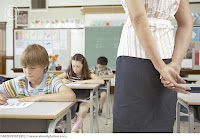There are four areas of knowledge that are crucial when educating a child in spelling, and they further aid children to acquire diverse strategies when learning to spell.
1. Phonological knowledge
In order for a child to learn how language works, they must link a word with its sound. At the pre-phonetic stage a child understands the connection between sounds, letters and words.
At the phonetic stage sound cues are still understood but they also see that "words are usually spelt as they sound" and "commonly seen words are spelt correctly" (Winch, Johnston, March, Ljungdahl, & Holliday, 2001, p. 105).
To be a good educator of spelling, one will teach students about words and the patterns embedded within them.
- Phonemes are the smallest class of sounds. e.g. map is made up of three sounds.
- Blends are diverse sets of phonemes that form together and can be made up of a two or three letters. e.g. scratch.
- Diagraphs are pairs of letters that make a single sounds (can be consonant or vowel diagraphs). e.g. ch as in chief.
- Dipthongs are sequences of two vowels that are perceived to be one syllable. e.g. boy, wide, eye (Winch et al., 2001).
A person who is an articulate speller can look at a word and decide whether it appears 'right' or not, based on previous memory of word patterns and parts. People who read a lot have reinforcement visually of previous texts, and have visual memories of what a word looks like (Winch et al., 2001).
Morphemic knowledge refers to the units of which words exist, such as suffixes, prefixes and word bases. For example, the word running is made up of two morphemes; runn and ing. If students comprehend patterns in words spelling will become much easier for them (Winch et al., 2001).
Bases of words relate to words belonging in word families. e.g. swim, swimmer and swimming are derived of a like base. The base of a word can be added to with prefixes and suffixes.
Prefixes are "letters put before a word that add to or qualify its meaning" (Winch et al., 2001, p. 266). e.g. unattached means not attached.
Suffixes can "alter the spelling or grammatical status of a word" (Winch et al., 2001, p. 267).
-ng, -ship, -ry, -ing, -tion and -sm are examples of everyday suffixes.
4. Etymological knowledge
Etymology relates to this history and background of a word, and by knowing the origin students can become more interested in the spelling of that particular word (Winch et al., 2001).





















